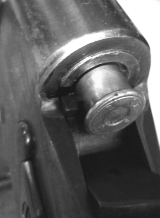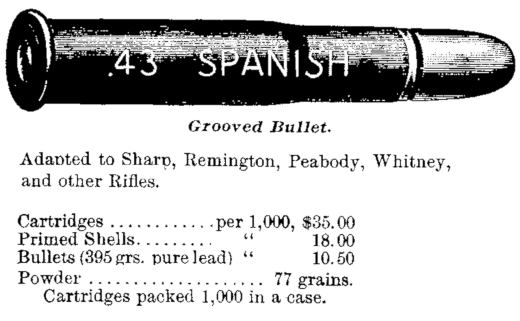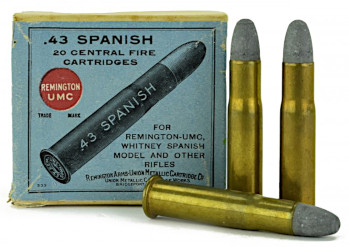Difference between revisions of "43 Spanish"
m |
m |
||
| Line 6: | Line 6: | ||
* U.M.C. 43-77 | * U.M.C. 43-77 | ||
| − | [[Image: | + | [[Image:Cartridge43spanish01b.gif]] |
''11.15x58Rmm (43) Spanish Remington (11x53mm Spanish) - Chapter 7 Cartridges of the World, Military Rifle Cartridges of the World.'' | ''11.15x58Rmm (43) Spanish Remington (11x53mm Spanish) - Chapter 7 Cartridges of the World, Military Rifle Cartridges of the World.'' | ||
Latest revision as of 17:24, 3 September 2023
.43 Spanish - A centerfire firearms cartridge developed by Remington designers in the 19th Century.
- .43 Spanish
- 11mm Spanish
- 11.15×58mmR Spanish Remington
- U.M.C. 43-77
11.15x58Rmm (43) Spanish Remington (11x53mm Spanish) - Chapter 7 Cartridges of the World, Military Rifle Cartridges of the World.
In 1867 the Spanish military upgraded their rifles with the Remington Rolling block chambered in the 11.15x58mmR cartridge. This cartridge goes by many names including the .433 Spanish, 11mm Spanish and the most widely know as the .43 Spanish. The Remington Rolling block was introduced in 1864 and is a breech loading rifle that has an extremely strong action. Remington manufacture it until 1918 in numerous calibers including smokeless cartridges like the .30-06, 7×57 Mauser and the 8x50mmR Lebel.
The cartridge was almost similar to the .44-77 cartridge except for the difference in their diameters. The Spanish military version of the cartridge was later upgraded in 1889 to a "heavier, brass-jacketed reformado bullet". While Remington stopped manufacturing the cartridge in 1918, its use in the United States became widespread after World War II because it was sold as a surplus. The Caliber .43 Spanish 11.15x58R is not to be confused with the Spanish Reformado cartridge.

The Spanish Reformado typically won't chamber in a Remington .43 Spanish chambered rolling block rifle.
Remington Rolling Block Rifles made in Ilion, New York (so marked on the tang) can be found chambered for .43 Spanish (11.15 x 58R) cartridge or for other similar cartridges including the .43 Egyptian, 11mm Danish, .44-77 and other lesser known cartridge designs.
- The .43 Spanish (11.15 x 58R) uses a .439" diameter lead bullet.
- The .44-77 Remington (aka .44-77 Sharps) uses a .446" diameter lead bullet.
- The .43 Spanish Reformado is similar, but original cartridges use a .451" diameter brass jacketed bullet.
- The .43 Egyptian uses a .439" bullet, but the rim and head diameter are much larger.
Rolling Block Rifles made in Scandinavian countries, under Remington license, may be rimfire, centerfire, or may have both styles of firing pins. Many variations of European cartridge chamberings exist.
The .43 Spanish used a .454-inch diameter bullet that weighed 396 grains. Its 1,280 fps was powered by 74 grains of powder.
RECHAMBERING
It is possible to have the Remington Rolling-Block surplus rifles rechambered from .43 Spanish to accept the full-length 348 Winchester case, which can easily be neck-expanded to take 0.439" diameter bullets.
DETERMINE RIFLE CALIBER
You will have to make a chamber cast. Cerrosafe is the easiest product to use when making a chamber cast. Its low melting point and minimal shrinkage make it ideal for getting an accurate look at your chamber. This process is as simple as wiping the bore dry, plugging the barrel with a patch, and pouring the Cerrosafe into the chamber.
Cerrosafe shrinks slightly while cooling, allowing for easy removal from the chamber. The characteristics of Cerrosafe make it expand back to its true size after one hour of cooling. Brownells, Inc. states that after cooling for 200 or so hours, the cast will expand about .0025″ of an inch.

